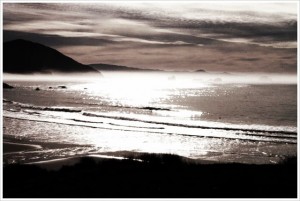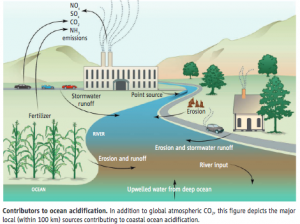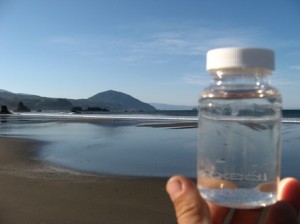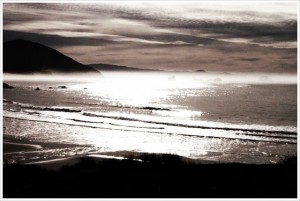
The emerging issue of ocean acidification (OA) has been getting a lot of recent attention via media, in community ocean forums, and by elected officials wondering what role governments might be able to play in addressing its impacts. While it’s important that we recognize that this is a global issue largely resulting from the increased amount of carbon dioxide (CO2) being pumped into the atmosphere and absorbed by the ocean, it’s also important to understand that there are local actions that can help mitigate the impacts of acidification on aquatic ecosystems and regional economies and cultures. Many of these local actions are directly connected to Surfrider’s existing clean water programs and campaigns.
Understanding the causes of OA
Over recent years, human activities such as the burning of fossil fuels (coal, oil, natural gas) have increased the amount of carbon dioxide gas emitted to the atmosphere—and the amount that dissolves into the ocean. Now, so much carbon dioxide has been absorbed by the ocean that the chemistry of seawater is changing, causing the ocean to become more acidic. Read more in the Beachapedia post on ocean acidification.
Several recent studies (see WA Document and Kelly et al. below) also document the presence of local coastal acidification hotspots where freshwater inputs, pollutants, and soil erosion are blamed for acidifying waters (lowering the pH) at higher rates than atmospheric CO2 alone. These non-atmospheric inputs can have large consequences when combined with upwelling events that bring low pH water to nearshore areas and additional sources such as sulfur dioxide precipitation, hypoxia, eutrophication, emissions and run-off of acidic fertilizers.
The Seattle Times recently published an in-depth 3 part series called “Sea Change” which includes a comprehensive summary on ocean acidification, cool videos, and some of the affects on local crabbers & shellfish growers.
Our friends at COMPASS have been doing a great job of connecting the science from cutting edge research done here in Oregon with state policy makers. Click on the links below to view a couple of handouts presented on a recent field trip with Oregon Legislators.
Local Actions & Solutions
Oregon scientists and shellfish growers at the Whiskey Creek Oyster Hatchery first recognized OA issues back in 2008. Other hatcheries in the Puget Sound also began experiencing problems around the same time and these observations have led to an increased amount of scientific attention by researchers in both states. Since then, the State of Washington has been stepping up to the challenge of better understanding the issues we are going to face in the years to come and providing recommendations on actions to take towards mitigating the impacts. Given that Washington produces approximately 70% of America’s shellfish, it’s no surprise that they are taking this challenge very seriously. The States of California and Oregon have recently announced their participation in a West Coast Science Panel on OA and Hypoxia.
The State of Washington convened a Blue Ribbon Panel to address the emerging issue of OA and in 2012 published a report called: “Ocean Acidification: From Knowledge to Action, Washington State’s Strategic Response”. While lengthy, this report includes some really great recommendations for action at the local and state level that can and should be taken to address this emerging threat.
Another recent paper by Kelly et al. 2011 titled "Mitigating Local Causes of Ocean Acidification with Existing Laws" dives into the local sources of pollution that are exacerbating OA at a local level, and provides policy recommendations that can be taken by local municipalities and State Governments. These local pollution sources are directly connected to and addressed through Surfrider’s existing Blue Water Task Force, Know Your H2O, and Ocean Friendly Gardens programs. Of specific interest to Surfrider and our existing clean water programs:
“First, the Clean Water Act directs state government agencies to ensure that precipitation runoff and associated pollutants (which can increase acidification) are monitored, limited, and consistent with the sustainable functioning of aquatic ecosystems. Stormwater surge prevention (e.g., holding tanks), coastal and riparian buffers (areas of vegetation near land-water intersections), intact wetlands, and improved onsite water treatment facilities are effective measures to address watershed runoff and associated pollutants. In many cases, federal funding is available to help local governments complete these kinds of projects, and local watershed groups provide a grassroots base for ensuring that states and EPA meet their responsibilities…Second, controlling coastal erosion is a classic function of local and state governments and one that could markedly benefit coastal ecosystems by reducing nutrient and sediment loading of water and protecting the physical integrity of the habitat itself. Such coastal inputs may be enriched with fertilizers and, if unchecked, can further increase acidification in estuaries and coastal waterways. Independent local actions, such as increasing vegetation cover, may be effective at small scales, but concerted action among multiple local jurisdictions—as would likely be necessary to address erosion within an entire watershed, for example—may require coordination among state or regional governments”
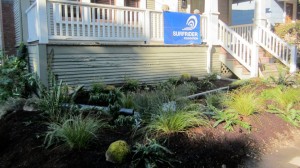 Ocean Friendly Garden installed by Portland Chapter
Ocean Friendly Garden installed by Portland Chapter
So, how can I be part of the solution?
I often hear this question asked after presentations from researchers on the science of OA, and I also frequently see people throw their hands up in the air and say we’re screwed. While time will tell whether or not we will be able to ride this out, there are a number of ways that we can all be a part of the solution in our everyday lives and help to ensure that we leave a healthy ocean for future generations.
Here are a few:
-Educate your family, friends, and neighbors about this issue: It’s estimated that only 7% of the population understands what OA is, and very few understand that we can be a part of the solution. Share this blog post with your networks and talk with people about this emerging threat to our quality of life. Check out the FAQ on ocean acidification and 20 Facts about OA.
-Walk, ride a bike, or take public transportation as much as possible: The US EPA estimates that 31% of all CO2 emissions in the US are generated from transportation. We are making strides to reduce our consumption of fossil fuels, but we must do better. Install copper-free brake pads in your car.
-Plant trees and native vegetation (especially in riparian areas): Trees and shrubs sequester carbon dioxide that is absorbed through photosynthesis, help to control erosion, and filter nutrients and sediment. Here in the PNW we have some of the highest rates in the world of carbon biomass in our forests, which means we have the capacity to absorb a great amount of CO2 from the atmosphere. Participate in restoration projects in your community with groups like Watershed Councils or install a Ocean Friendly Garden at your home using native plants to filter runoff.
-Reduce or Eliminate the amount of Fertilizers, Pesticides and Chemicals used around your home: These basic Ocean Friendly Garden principles are common sense as they have a degrading effect on the watershed and contribute to local acidification as runoff after storms. Eliminating their use will also save you money.
-Volunteer to Collect Water Quality Samples: Your local Surfrider Chapter or other watershed groups are frequently monitoring the health of our watersheds, estuaries and nearshore Ocean and they could greatly use your help. Getting out there to collect samples is a great way to better understand local conditions and raise awareness to the threats facing our aquatic ecosystems. Participate in the X-prize!

